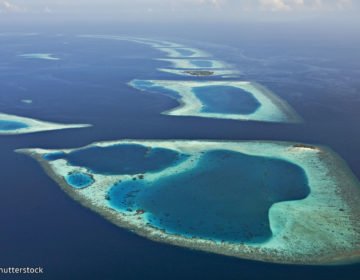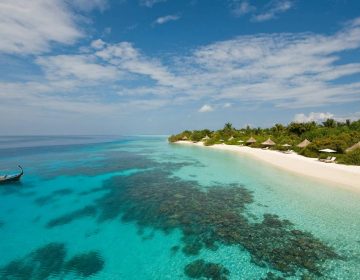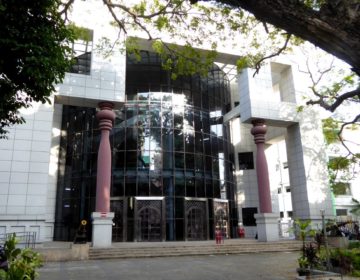If you’re a beach-lover, sun bunny, or simply need to get away from your hectic life, then a stay at a beautiful Maldives resort could tick all of the right boxes. When it comes to planning for your once-in-a-lifetime getaway, it’s worth doing a little research in order to make sure that you’re ready and able to get the most out of your holiday. There are also a few different customs and laws when it comes to Maldives that you need to be aware of.
We’ve done the research for you and put together an ultimate guide to the Maldives, which covers a whole range of information including how to get in and around, major airports, currency, customs, flora and fauna, popular activities, and details on when is the best time to visit the Maldives. We have even a few extra tips and tricks to help you to get the best Maldives deals around.

Where Are the Maldives?
No doubt you’ve heard all about the Maldives, scrolled through countless pictures of palm-fringed beaches and sugar-white sands, but do you know exactly where the Maldives are? Many people would struggle to point the Maldives on a map. The Maldives are actually located below Sri Lanka, and underneath the southern tip of India. The country is made up of over 1200 coral Islands, yet out of these only 200 are inhabited while only 105 have Maldives resorts on. In fact, the whole area covers just 297 square kilometres, which makes it one of the most dispersed countries in the world – and sitting at just 1.5 m above sea level it’s also the lowest countries in the world.
The Maldives are made up of 26 different atolls, and they are positioned within both the Arabian Sea and the Indian Ocean. The Maldives are located 5200 miles from London, 8700 miles from New York, and a whopping 15,600 miles from Los Angeles.
How to Get in and Around
If you’re traveling internationally, the only why you can get into the Maldives is to fly into the main airport (Mali Velena International Airport, MLE) which is located on the island of Hulhule.
Once you arrive at the airport, you will most likely have to get a seaplane or speedboat to your hotel or resort. A seaplane journey can be a real highlight of any trip, and it provides a way for you to soar over the beautiful islands that are speckled below. A top tip is to make sure that you grab your camera or phone out your bag before you take-off, as you will often be required to place all of your belongings towards the back of the plane. It’s worth noting that seaplanes will not depart after dark, so make sure that you book your international flights around this.
All resorts will be able to organise your seaplane flights for you, however, they will often come at an additional cost on top of the resort price. You can also choose to hire your own private seaplane either to get you from the international airport to your resort, or to take you out and about on a island-hopping day trip.

Finally, the only other way to really get around is on a live aboard boat. This is where you can sail or cruise around those idyllic Maldives islands. This is a particularly beneficial option for keen divers and snorkelers, as equipment and dives are often included in the package price.
Only a handful of the major islands actually have main roads, cars and motorbikes. If you are staying on one of the resort islands, then most likely the only way to get around is on foot, on a bicycle, or even by golf buggy if you book one of the more exclusive, high-end resorts.
Currency and Money
The unit of money in the Maldives is called the rufiyaa (Rf). Notes come in denominations of 500, 100, 50, 20, 10 and five and two rufiyaas. If you’re staying at a big resort, you’ll find that you won’t need to carry much money at all. Every single purchase can be billed to your room, and then you can choose to pay by any form of major credit card including American Express, Visa, and Mastercard. JCB and Diners Card payment options are less frequent, so check with your resort before you go if that is your prefered method of paying.
It’s always a nice idea to keep some cash on you at the resort to tip. Many Maldives resorts say that tipping is not mandatory, however, it is a really lovely touch should you wish to tip someone who made your vacation extra special. You can do this by placing cash inside of an envelope and leaving it in your room, or by handing it directly to the person you want to give it to. Different resorts will have different tipping rules and regulations, and some choose to share it out between all staff members.
If you’re travelling with dollars or euros or pounds, you can get them exchanged at one of the trustworthy currency exchange booths located inside of Male International Airport. It’s worth noting that if you’re visiting one of the major tourist islands, you can also choose to pay in dollars, pounds or euros too. If you need to make an international transfer then you can make use of the ‘Swift’ transfer system which provides an efficient way to transfer money while staying in the country.

Maldivian money rufiyaa: different banknotes and coins closeup.
Local Flora and Fauna
The Maldives have one of the most diverse marine-life in the world, and the flora can vary depending on what side of the Maldives you choose to visit. Many of the sandy islands feature mangroves, bamboo trees, tropical vines, huge banana trees, and towering coconut palms. Some of the wetter islands have areas of protected rainforest. One of the most fertile islands in the South is called Fuvahmulah. On this island you can find a large selection of fruits including pineapples, watermelons and citrus. Sweet potatoes, yams, and millet also grow in the Maldives.
On some of the larger islands, you can spot giant fruit bats as well as flying foxes at dusk. There is also a variety of colourful lizards, but domesticated animals are rare although you find the old chicken, cat or rabbit on the larger local island. Birds in the area include the white-breasted waterhen, as well as a few migratory birds that travel here at certain periods throughout the year. Herons can sometimes be spotted in shallow water and seagulls also frequent some of the large Islands.
The Maldives are often hailed as the best diving hotspot, and it attracts underwater enthusiasts from around the globe. The algae-rich coral reefs are home to a huge variety of marine life including over 700 species of fish.
A variety of shark species are also found here, you may encounter friendly white tip reef sharks. These types of sharks are non-aggressive and actually quite timid. If you’re really lucky you can get to see the world’s largest fish species – and that is the whale shark. Many diving hotspots actually take guests on diving tours just to view this beautiful majestic creature. Other underwater life includes stingrays, manta rays, eels, and turtles.

Maldives Customs
Is actually illegal to bring any form of alcohol into the Maldives, and they do check by screening your bags on entry so make sure that you leave the tipple at home. All of the major Maldives hotels and resorts will offer both local and international alcoholic spirits and wine – so don’t worry about not being able to find what you like.
Many of the Maldives traditions and customs don’t actually apply if you are staying on an Island Resort. If you are out and about in one of the local islands you can respect those traditions by making sure that your body is suitably covered, and that you refrain from public displays of affection.
Things to Do in the Maldives
The main reason why people choose to vacation in the Maldives is for some serious rest and relaxation. The pristine provide the perfect place to chill and unwind with a book (or a cocktail) in-hand. If you are staying at an island resort they can usually arrange excursions such as diving, snorkelling, dolphin-watching, fishing and the likes. Some Maldives resorts can even set up private dinners for you on a secluded part of the beach. There are also things to help you to stay fit and healthy when you are away, such as 24-hour fitness centres and yoga teachers which teach group or private classes as well as things like meditation.
Many people choose to stay in their Maldives resort and stick to this laid-back way of life. If you do feel like you want to explore some real culture then you can take a trip to one of the main Islands. Here you can wander the streets, enjoy some Maldivian cuisine, and even pick up some traditional handicrafts from local sellers. Your concierge will be able to put together an excursion for you.

Best Time to Visit the Maldives
The best time to visit the Maldives totally depends on both your budget and weather preferences. If you really want to go when the sun shines most, then we recommend visiting during the high season which runs between December and March. During this time prices are at the highest -particularly around Christmas and New Year, so be prepared to play double or more for your stay compared to the low season. Rooms often get booked up really high in advance, so make sure you plan your trip very early on if you want to get your first room choice.
Saying that, if you don’t mind a bit of rain here and there and also love to get a good deal on your Maldives vacation, then a visit during the low season which runs between May and October could be best for you. If you do travel during this period then expect rain, but it is often quite enjoyable to listen to the pitter-patter of rain in your overwater thatched villa.
Almost all resorts have a range of activities and indoor events to keep guests entertained when the heavens open. Another benefit of choosing to visit during the low season is that the resorts are often much less crowded, and you can enjoy a slice of pizza to yourself.
Tips For Booking Your Holiday to the Maldives
If you’re on the hunt for a great-value Maldives vacation, then we recommend checking out our article on the best cheap holidays in the Maldives. A few things to think about include flexibility. If you can be flexible with your departure dates you will have a much better chance of landing some great deals on flights. You can use Skyscanner’s flexi fare calendar to view flight prices over a whole month or even year! Studies also show that the cheapest day of the week to fly is on Wednesday, while the mot expensive is Saturday followed by Sunday.
You can also look into alternative departure airports, choosing stopovers or even booking a multi-destination holiday to save on flight costs. You can also make use of things like air miles, cash back programs as well as loyalty schemes. There has also been a recent increase in Maldives package holidays, so take a look at these to see what’s around before you book.

Are you ready to book your holiday to the Maldives? Why not have a look at our best resort recommendations? We also have an excellent article on the best time to visit the Maldives. With a little reading and research, you will be able to narrow down your best resorts and find a great deal for your next Maldives getaway. Enjoy!



